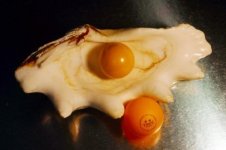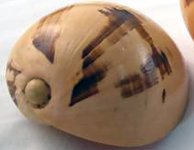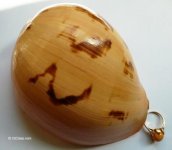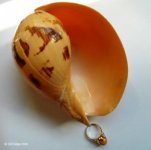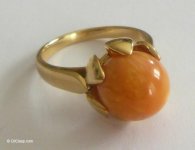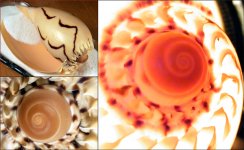You are using an out of date browser. It may not display this or other websites correctly.
You should upgrade or use an alternative browser.
You should upgrade or use an alternative browser.
Giant Melo Melo
- Thread starter KAC
- Start date
Caitlin
Well-known member
What's with the color? It is so strong and a bit different hue than the shade in the shell. It that the shell it came from?
SteveM
Well-known member
- Joined
- Jan 29, 2007
- Messages
- 2,113
The color is fine, can't ID the shell in the photo but it would have been chosen primarily for contrast. My problem with melos is the EXTREMELY high percentage of rounds (in fact, that's all you see!), in large sizes. That is coupled with a high tolerance among the pearl labs for polishing and shaping. In fact, it becomes almost impossible, from even the most technical point of view, to distinguish a shaped pearl from one carved from the inner whorl of the shell (bottom view of melo shell below).
Ironically, the ease of association between melo shells and their purported pearls gives rise to lax scientific standards of verification. Finding someone who has actually witnessed a melo pearl being extracted from the mollusk is probably about as rare as it is with Nautilus?
Additionally, the astronomically high prices paid for these, principally by Asian collectors, has resulted in rapacious harvesting of this once-prolific shell.
Ironically, the ease of association between melo shells and their purported pearls gives rise to lax scientific standards of verification. Finding someone who has actually witnessed a melo pearl being extracted from the mollusk is probably about as rare as it is with Nautilus?
Additionally, the astronomically high prices paid for these, principally by Asian collectors, has resulted in rapacious harvesting of this once-prolific shell.
Attachments
tango jhaveri
New Member
how do you value melo pearls?... i saw 2 melo pearls witha trader... weight of each pearl was approx 50 ct...and had a bangkok lab cert stating them to be non nucleated melo pearls...the trader did not allow me to take a pic of the pearls...i am interested in buying them but dont know its real worth....can anybody hellp me with the pricing of melo pearls..
CLICLASP
Well-known member
Just my small contribution of a melo melo pearl and the bailer snail ...What's with the color? It is so strong and a bit different hue than the shade in the shell. It that the shell it came from?
Attachments
CLICLASP
Well-known member
In the "old" pearl-guide I had the opportunity to say that I am the lucky owner of the 10,28 carats shown here
http://www.palagems.com/melo_myanmar.htm
And here is a freshly taken photo, the pattern/ flamme is not completely regular but the color is deep and the shape is nearly round. I like it very much...
What is funny it that I bought the shell in Portugal, years before I became a collector of fine pearls and did not know anything about the bailer snail.
http://www.palagems.com/melo_myanmar.htm
And here is a freshly taken photo, the pattern/ flamme is not completely regular but the color is deep and the shape is nearly round. I like it very much...
What is funny it that I bought the shell in Portugal, years before I became a collector of fine pearls and did not know anything about the bailer snail.
Attachments
CLICLASP
Well-known member
Here is a terrific one I saw in London 2 years ago
https://www.pearl-guide.com/forum/p...london-journey-more-stories-about-pearls.html
Some more photos on a post by Blaire
https://www.pearl-guide.com/forum/n...-melo-melo-pearl-pearl-ate-new-york-city.html
https://www.pearl-guide.com/forum/p...london-journey-more-stories-about-pearls.html
Some more photos on a post by Blaire
https://www.pearl-guide.com/forum/n...-melo-melo-pearl-pearl-ate-new-york-city.html
GemGeek
Pearlista
Thanks, excellent shot, enlarges very nicely on the screen. It's very well set to best advantage of the pearl.
I really like the size. Those orange golf balls just don't move me, aside from my expressed suspicions.
1) Large round melo pearls are not unusual. 2) Melo pearls are rare. These two statements look like they don't go together, but they do. If there is going to be a melo pearl, it has a decent chance of being fairly round.
The shell is enormous, but it isn't thick enough to carve out huge "pearls". When you've seen a lot of them, which can be hard to do in person, you can get a better appreciation of their structure.
CliClasp's pearl is exquisite and I love the setting.
CLICLASP
Well-known member
I have always been wondering where does the natural pearl exactly hide in the shell, for exemple the conch, does it get into the pointy parts of the shell?
And the melo melo, does it hide near the bottom where the snail starts wrapping? ah who knows?
And the melo melo, does it hide near the bottom where the snail starts wrapping? ah who knows?
CLICLASP
Well-known member
Those orange golf balls just don't move me, aside from my expressed suspicions.
I have seen a big melo melo set on a bracelet and I can assure it looked fantastic, it was in a book on jewels from organic material (coral, pearl,horn, tortoise-shell) , maybe translated ?
CLICLASP
Well-known member
The shell is enormous, but it isn't thick enough to carve out huge "pearls".
The shell is very thin, true, but what about Steve's comment?
a shaped pearl from one carved from the inner whorl of the shell
This bottom part seems thicker, unfortunatly I cannot check by myself, my daughter took the shell, but I would like to know ...
Caitlin
Well-known member
In the "old" pearl-guide I had the opportunity to say that I am the lucky owner of the 10,28 carats shown here
http://www.palagems.com/melo_myanmar.htm
And here is a freshly taken photo, the pattern/ flamme is not completely regular but the color is deep and the shape is nearly round. I like it very much...
What is funny it that I bought the shell in Portugal, years before I became a collector of fine pearls and did not know anything about the bailer snail.
So cool...... I love your artistry.
SteveM
Well-known member
- Joined
- Jan 29, 2007
- Messages
- 2,113
My intent is not to intimate the category per se is fake (although it is interesting to note that Melo-Melo pearls did not even exist as such 20 years ago, until certain findings of provenance were made by GIA Bangkok).I have seen a big melo melo set on a bracelet and I can assure it looked fantastic…
But consider the unprotected harvest of tens of thousands of these animals without regard for their (reputedly inedible) meat, driven by the high prices paid by Asian collectors for the orange ping-pong (my correction) balls, demand seemingly insatiable and rising. That's a lot of shells, each possessing that tempting inner whorl to work with. Top that with the centuries of superb shellcarving craftsmanship in the region, amplified by modern high-tech polishing equipment, and you have a 'situation.' Carved gastropod shell is capable of throwing flame to compete with all but the best shell/pearl surfaces.
The most important aspect of a lab certificate would be that it clearly state 'no evidence of treatment or polishing' which would provide reasonable assurance that it is a pearl.
I've got a beautiful but adolescent Melo broderipii (close relative) shell coming from an auction in a few weeks, if images of its shell offer additional insight I will post.
My bottom line: It's a conservation issue.
SteveM
Well-known member
- Joined
- Jan 29, 2007
- Messages
- 2,113
Not sure about insight, but some nice images?I've got a beautiful but adolescent Melo broderipii (close relative) shell coming from an auction in a few weeks, if images of its shell offer additional insight I will post.
Primarily I wanted a closer look at the larval shell, also known as protoconch ('inner whorls') of Melo sp. In this very young shell the larval stage remains prominent, and conveniently translucent as well.
Attachments
GemGeek
Pearlista
That is beautiful. I love the backlit photo. It reminds you of why lamps are made from shells. 
Similar threads
- Replies
- 7
- Views
- 489

